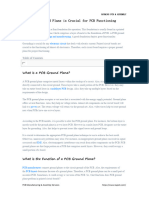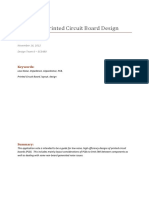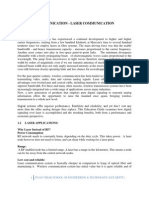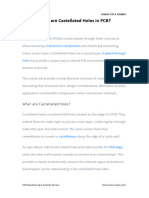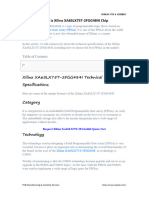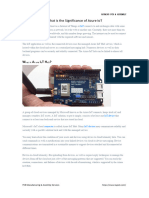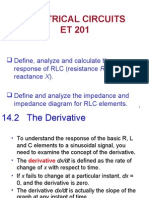A Comprehensive Guide On Advanced Circuits Stackup
A Comprehensive Guide On Advanced Circuits Stackup
Uploaded by
jackCopyright:
Available Formats
A Comprehensive Guide On Advanced Circuits Stackup
A Comprehensive Guide On Advanced Circuits Stackup
Uploaded by
jackOriginal Description:
Original Title
Copyright
Available Formats
Share this document
Did you find this document useful?
Is this content inappropriate?
Copyright:
Available Formats
A Comprehensive Guide On Advanced Circuits Stackup
A Comprehensive Guide On Advanced Circuits Stackup
Uploaded by
jackCopyright:
Available Formats
RAYMING PCB & ASSEMBLY
A Comprehensive Guide on Advanced Circuits Stackup
The rapid development in the electronics industry has continued to increase the need for lightweight and
compact boards. Also, the miniaturization of circuit boards has helped the production of compact and
complex electronic devices. Therefore, this development has resulted in the popularity of multilayer boards.
These boards involve the combination of two or more double-sided or single-sided boards stacked together.
Proper stackup is crucial in multilayer circuit boards. This is because stackup affects the performance and
functionality of a printed circuit board. A multilayer circuit features three or more conductive layers with
one layer placed on the insulation board and two layers outside. The increase in the densities and
complexities of PCBs could result in issues like stray capacitance, cross-talk, and noise.
Request PCB Manufacturing & Assembly Quote Now
Table of Contents
What is a Stackup?
A stackup refers to how copper and insulating layers are arranged to create a PCB before board layout design.
Also, a stackup enables manufacturers to get more circuitry through different PCB board layers. A PCB
stackup can help to reduce the vulnerability of a circuit to external noise. Also, it reduces radiation and
crosstalk concerns on high-speed PCB layouts.
A multilayer circuit board comprises inner signal layers, power plane, and ground plane. Several layers in a
circuit board help to increase the ability of a board to disperse energy. A PCB stackup is simply the
arrangement of copper and insulating layers in a circuit board design. Manufacturers arrange these layers to
achieve functionality in circuit boards.
Optimal stackup in multilayer circuits is one of the most crucial factors that determine electromagnetic
compatibility (EMC) performance. A good layer stack-up can reduce radiation and can prevent interference
in circuits caused by external noise sources. Also, a well-stacked circuit board substrate can minimize
impedance mismatch and crosstalk issues. However, a poor stackup can result in EMI radiation since ringing
and reflections in the systems can reduce PCB performance.
Common Types of PCB Layer Stackups
PCB Manufacturing & Assembly Services https://www.raypcb.com/
RAYMING PCB & ASSEMBLY
10 Layer PCB Stackup
There are various PCB board layers. The EMC requirements of the board and the size of the circuit are
factors that determine the number of layers in a board. After determining the number of layers your board
needs, you will have to determine the board layout.
2 layer stackup
A 2 layer board which is also known as a double-sided board is a type of multilayer board that allows
interconnects on both sides. These circuit boards comprise three material layers which are the signal layer,
laminate core, and bottom layer. Two of these layers are functional.
Also, the signal layer is the top layer. It features copper within a particular range of thickness. The laminate
core is the layer that separates the bottom and top copper layers. Therefore, it keeps the copper layers
isolated. The bottom layer is similar to the signal layer. It is the second layer of copper.
Request PCB Manufacturing & Assembly Quote Now
4 layer stackup
A 4 layer PCB stackup features 4 layers to route electrical signals. Also, the PCB manufacturer sandwiches
these layers together. These layers are the bottom layer, top layer, and two inner layers. The bottom and top
layers are on the outside while the two inner layers are between them. Manufacturers place components on
the top and bottom layers of a 4 layer PCB.
PCB Manufacturing & Assembly Services https://www.raypcb.com/
RAYMING PCB & ASSEMBLY
The inner layers can’t create external connections. Therefore, they serve as power planes for routing signals.
This helps to improve trace signal quality and also minimize EMI emissions. It is not advisable to make the
inner layers signal layers. If your PCB project requires four signal layers, you will need to consider the 6
layer PCB stack up.
The 4 layer PCB stack up comprises top layer-inner layer 1- inner layer 2-bottom layer. Also, the 4-layer
PCB stackup offers enhanced functionality. However, the 4 layer PCB stack up may not be ideal for some
applications. You can switch the ground layers of a 4 layer PCB stack up based on the layer having more
signals. A 4 layer PCB stackup features the power and ground planes as the inner layer. A 4 layer stackup
produces a board thickness of 0.062.”
6 layer stackup
A 6 layer stackup is a 4 layer stackup with two more signal layers. Therefore, 6 layer stack up comprise four
routing layers and two internal planes for power and grounding. This means that a 6 layer stack up comprises
two outer and two internal layers, one ground plane, and one power plane.
This stackup arrangement for a 6-layer PCB is very common. This is because this stackup arrangement
provides a balance between high-speed signaling and EMI control. Also, this stackup runs high-speed signals
via the two buried layers. However, this design isn’t ideal for all applications.
For instance, you will need to place the power planes and ground planes close to each other for high-speed
designs. A 6 layer stackup feature board thickness between the range of 0.031 and 0.062
8-layer stackup
An 8 layer PCB stackup provides better options as it adds two more layers for performance or routing. Also,
it is an advanced circuit stack up that sets to achieve the objectives of a multilayer PCB design. A typical 8
layer stackup comprises ground and power planes in the center. Therefore, this provides great capacitance
between layers. Also, it protects signal integrity by separating the second and third signal planes.
An 8 layer stack up comprises four signal layers, two power planes, and two ground planes. Also, 8-layer
stackup doesn’t include more than four signal layers. Rather than adding more signal layers, this PCB
includes more ground and power planes. The board thickness for an 8 layer board is available in 0.093”,
0.0125”, and 0.062.”
10 layer stackup
If the requirement of your PCB design involves six routing layers, a 10 layer stack up is an ideal choice. A
10 layer PCB stackup comprises four planes and six signal layers. Therefore, it features a tight coupling
between the return and signal planes. A 10 layer stackup offers board thickness that ranges from 0.062” and
0.125.”
PCB Manufacturing & Assembly Services https://www.raypcb.com/
RAYMING PCB & ASSEMBLY
This PCB stackup arrangement routes high-speed signals on the internal signal layers. Therefore, this
stackup offers exceptional signal integrity when properly routed and stacked. Also, it offers excellent EMC
performance. It isn’t advisable to replace any of the power or ground planes with signal layers. If you do so,
it could lead to poor performance. A 10 layer PCB stackup features multiple ground planes.
Request PCB Manufacturing & Assembly Quote Now
Objectives of a Multilayer PCB Stackup
While creating a multilayer stack up, manufacturers set out to achieve some objectives. Multilayer stackups
design must meet certain design requirements. Therefore, multilayer boards should achieve the following
objectives:
Signal layers must be adjacent to planes
Multiple ground planes lower impedance and radiation
Ground and power planes must be closely coupled together
Route high speed signals through buried layers between planes
Signal layers must be closely coupled to their planes
PCB Manufacturing & Assembly Services https://www.raypcb.com/
RAYMING PCB & ASSEMBLY
While achieving these objectives is crucial, it is crucial to know that not every PCB layer stack up will meet
all these objectives. Therefore, it is important to work with professional engineers to determine the
objectives you should prioritize.
Benefits of PCB Layer Stackups
A PCB stackup offers a lot of benefits in electronics devices. The introduction of multilayer boards has
contributed to the development of advanced electronic devices. Also, multilayer boards comprise at least
three conductive layers. Due to the number of conductive layers in these boards, they offer great
functionality. While PCB layering may be more complex, PCB stackups offer these benefits:
Reduce vulnerability
Multilayer PCBs can shield an inner layer from external noise. Therefore, this makes them less vulnerable to
exterior forces. Also, it can reduce radiation and impedance problems on high-speed systems.
Improve functionality
Multilayer PCBs can improve the functionality and speed of an electronic device. Also, these boards can
enhance electromagnetic compatibility of a board. Also, solid ground planes and power planes can help to
minimize EMI emissions. This can as well improve signal quality on the traces.
Minimize costs
A properly arranged PCB stack up can help to achieve lower production costs. This is because these stackups
place multiple circuits on a single board.
Reduce radiation
A good stackup can reduce radiation from an electronic device, particularly in high-speed boards. Therefore,
it is crucial to arrange PCB stackup with functionality in mind. This is because poorly stacked layers can
cause impedance mismatches and this can lead to greater EMI radiation.
Request PCB Manufacturing & Assembly Quote Now
Factors to Consider when Creating a Multilayer Stackup
There are design factors you need to take into consideration when designing a multilayer stackup.
Core materials
For a normal single sided board, a manufacturer can use aluminum cores. Aluminum cores are not ideal for
multilayer stackups. This is because multilayer aluminum boards are very difficult to fabricate.
Interlayer offset
PCB Manufacturing & Assembly Services https://www.raypcb.com/
RAYMING PCB & ASSEMBLY
PCB layers can be offset when fabricating a multilayer PCBs. Therefore, you can prevent this by using rivet
and bowel method and hot melting for PCB design.
Bow and twist
Bow and twist can result from uneven distribution of copper in a multilayer stackup. Therefore, ensure you
design all multilayer boards symmetrically.
The inner layer copper thickness is a crucial factor when arranging PCB stackups. This is because board
thickness offers great functionality. With the right PCB layer stack, you can achieve great functionality. Also,
the board thickness is crucial when creating a multilayer stackup.
Conclusion
To maintain signal performance in a PCB layer stackup, the power plane is usually close to the ground plane.
Multilayer printed circuit boards offer great benefits. Therefore, a good layer stackup is critical in ensuring
functionality in these boards. Multilayer PCBs can have a board thickness that ranges from 0.4mm to
3.2mm.
Related Posts:
1. Where To Find Industrial Circuits – A Comprehensive Guide
2. Aurora Circuits – An Advanced PCB Manufacturer in the United States
3. A Comprehensive Guide to the Top Pads Schematics
4. A Comprehensive Guide to PCB manufacturing in Calgary
https://www.raypcb.com/advanced-circuits-stackup/
PCB Manufacturing & Assembly Services https://www.raypcb.com/
You might also like
- Power Failure Backup CompletoDocument93 pagesPower Failure Backup CompletoBrentilda100% (1)
- DC Power-System-Design-for-Telecommunications PDFDocument512 pagesDC Power-System-Design-for-Telecommunications PDFgirm2002100% (3)
- PAG 05.3 - Determining Frequency and Amplitude With An OscilloscopeDocument2 pagesPAG 05.3 - Determining Frequency and Amplitude With An OscilloscopejmsonlNo ratings yet
- Edn Best of Design Ideas 2012Document25 pagesEdn Best of Design Ideas 2012srescia67% (3)
- What Is The Layer of A PCBDocument11 pagesWhat Is The Layer of A PCBjackNo ratings yet
- A Critical Analysis of 7 Layer PCB and Its ApplicationsDocument5 pagesA Critical Analysis of 7 Layer PCB and Its ApplicationsjackNo ratings yet
- Layered PCB How Many Types of Layers of PCB Are ThereDocument8 pagesLayered PCB How Many Types of Layers of PCB Are TherejackNo ratings yet
- What Is The Inner Layer of A PCBDocument10 pagesWhat Is The Inner Layer of A PCBjackNo ratings yet
- 12 Layer PCB Manufacturing and Stack Up OptionsDocument12 pages12 Layer PCB Manufacturing and Stack Up OptionsjackNo ratings yet
- Why A PCB Ground Plane Is Crucial For PCB FunctioningDocument3 pagesWhy A PCB Ground Plane Is Crucial For PCB FunctioningjackNo ratings yet
- High Quality 8 Layer PCB ManufacturingDocument13 pagesHigh Quality 8 Layer PCB ManufacturingjackNo ratings yet
- What Is 3 Layer PCBDocument10 pagesWhat Is 3 Layer PCBjackNo ratings yet
- Stackup Planning AN2011 2Document8 pagesStackup Planning AN2011 2lavaskumarNo ratings yet
- Do's and Don'ts For PCB Layer Stack-Up: by - Pragnesh Patel & Ronak ShahDocument9 pagesDo's and Don'ts For PCB Layer Stack-Up: by - Pragnesh Patel & Ronak Shahbasit aliNo ratings yet
- Sibridge Technologies - Design Tip - Do's and Don'Ts For PCB Layer Stack-UpDocument6 pagesSibridge Technologies - Design Tip - Do's and Don'Ts For PCB Layer Stack-Upbhushan86No ratings yet
- Layer Stack InformationDocument9 pagesLayer Stack InformationMadhav DimbleNo ratings yet
- PCB Design Guidelines For EMI EMCDocument7 pagesPCB Design Guidelines For EMI EMCjackNo ratings yet
- 4 Layer PCB Layout Tutorial, Stack-Up Design, and Cost of ManufacturingDocument33 pages4 Layer PCB Layout Tutorial, Stack-Up Design, and Cost of ManufacturingjackNo ratings yet
- PCB Design For EMCDocument8 pagesPCB Design For EMCSally FangNo ratings yet
- 4-16 Layer PCB StackupDocument5 pages4-16 Layer PCB Stackupthomas andersonNo ratings yet
- 6 Layer PCB Stackup, Thickness and ManufacturingDocument15 pages6 Layer PCB Stackup, Thickness and ManufacturingjackNo ratings yet
- Stackup Design DocumentDocument12 pagesStackup Design Documents.boopathiNo ratings yet
- Printed Circuit Board: Presented by Ruby Kumari B.SC (MATHS), B.E (ECE)Document75 pagesPrinted Circuit Board: Presented by Ruby Kumari B.SC (MATHS), B.E (ECE)Ruby Pathak100% (2)
- What Is The Significance of Home Electronics PCBDocument6 pagesWhat Is The Significance of Home Electronics PCBjackNo ratings yet
- 28 Layer PCB An Integrated Multi-Layer PCBsDocument4 pages28 Layer PCB An Integrated Multi-Layer PCBsjackNo ratings yet
- WEEK-3 1. Component Package TypesDocument7 pagesWEEK-3 1. Component Package TypesNAVEENNo ratings yet
- What Do You Need To Know About Trace PCBDocument8 pagesWhat Do You Need To Know About Trace PCBjackNo ratings yet
- What is Via Stitching and Why it is Useful_ -2Document2 pagesWhat is Via Stitching and Why it is Useful_ -2SamrandNo ratings yet
- Presented by Ruby Kumari B.SC (MATHS), B.E (ECE)Document75 pagesPresented by Ruby Kumari B.SC (MATHS), B.E (ECE)AhmedMohabNo ratings yet
- How To Use and Design Interposer PCB in Chip PackagingDocument11 pagesHow To Use and Design Interposer PCB in Chip PackagingjackNo ratings yet
- How To Order PCB With Components in The Right WayDocument12 pagesHow To Order PCB With Components in The Right WayjackNo ratings yet
- A Closer Look at Analog PCB Design - Comprehensive GuideDocument17 pagesA Closer Look at Analog PCB Design - Comprehensive GuidejackNo ratings yet
- MultiSIM - PCB Layout PDFDocument29 pagesMultiSIM - PCB Layout PDFRomeu Corradi JúniorNo ratings yet
- Types and Applications of A Special PCBDocument6 pagesTypes and Applications of A Special PCBjackNo ratings yet
- How Can A Large PCB Be FabricatedDocument10 pagesHow Can A Large PCB Be FabricatedjackNo ratings yet
- What Are The Types and Applications of High Tech PCBDocument13 pagesWhat Are The Types and Applications of High Tech PCBjackNo ratings yet
- Low Noise Printed Circuit Board DesignDocument9 pagesLow Noise Printed Circuit Board DesignEmaxxSeverusNo ratings yet
- Tips and Tricks To Build Efficient 433mhz PCB Antenna DesignDocument16 pagesTips and Tricks To Build Efficient 433mhz PCB Antenna DesignjackNo ratings yet
- What Is IC SubstrateDocument20 pagesWhat Is IC SubstratejackNo ratings yet
- Printed Circuit BoardDocument50 pagesPrinted Circuit BoardIX17-41 Suvayu ChatterjeeNo ratings yet
- Basic Thing You Should Know About PCB Assembly ProcessDocument29 pagesBasic Thing You Should Know About PCB Assembly ProcessjackNo ratings yet
- What Is Buried Via PCBDocument10 pagesWhat Is Buried Via PCBjackNo ratings yet
- PCB InfoDocument19 pagesPCB InfoDarshan Iyer NNo ratings yet
- PCB Layout Design Tips - Grounding Considerations - OnElectronTechDocument17 pagesPCB Layout Design Tips - Grounding Considerations - OnElectronTechpapirojedecNo ratings yet
- Printed Circuit Board: CharacteristicsDocument23 pagesPrinted Circuit Board: CharacteristicsSai Gautam100% (1)
- Workshop PCB Desgin 28-10-23 FinalDocument48 pagesWorkshop PCB Desgin 28-10-23 Finalaswinikrn8No ratings yet
- What Is A Chip Antenna and How Does It WorkDocument12 pagesWhat Is A Chip Antenna and How Does It WorkjackNo ratings yet
- Printed Circuit BoardDocument23 pagesPrinted Circuit Boardahmed100% (2)
- RF PCB Design Guidelines You Must KnowDocument13 pagesRF PCB Design Guidelines You Must KnowjackNo ratings yet
- Designing Multi Layer To Balance SI by LeeRitcheyDocument85 pagesDesigning Multi Layer To Balance SI by LeeRitcheyram100% (1)
- Chapter-1 Wireless Communication - Laser CommunicationDocument56 pagesChapter-1 Wireless Communication - Laser Communicationyash_dk20083706No ratings yet
- Full Introduction About Antenna Types and PCB MaterialsDocument40 pagesFull Introduction About Antenna Types and PCB MaterialsjackNo ratings yet
- PCB Layer Stackup, PCB Stackup Design - PCBCartDocument5 pagesPCB Layer Stackup, PCB Stackup Design - PCBCartRintuMathunniNo ratings yet
- Use Vias On Pads For Designing and Manufacturing PCBsDocument12 pagesUse Vias On Pads For Designing and Manufacturing PCBsjackNo ratings yet
- What Is A PCBDocument8 pagesWhat Is A PCBKhushi Gupta100% (1)
- What Is High Speed PCB DesignDocument13 pagesWhat Is High Speed PCB DesignjackNo ratings yet
- Chapter - 1Document46 pagesChapter - 1Vineet KumarNo ratings yet
- How To Plan Stackup For Rigid Flex PCBDocument7 pagesHow To Plan Stackup For Rigid Flex PCBjackNo ratings yet
- What Are The Main Features and Benefits of The FPC AntennaDocument10 pagesWhat Are The Main Features and Benefits of The FPC AntennajackNo ratings yet
- Printed Circuit BoardDocument16 pagesPrinted Circuit BoardAjayChandrakarNo ratings yet
- How Main PCB Impacts The Functionality of Electronic DevicesDocument4 pagesHow Main PCB Impacts The Functionality of Electronic DevicesjackNo ratings yet
- What Are Castellated Holes in PCBDocument13 pagesWhat Are Castellated Holes in PCBjackNo ratings yet
- Automated Optical Inspection: Advancements in Computer Vision TechnologyFrom EverandAutomated Optical Inspection: Advancements in Computer Vision TechnologyNo ratings yet
- High-Performance D/A-Converters: Application to Digital TransceiversFrom EverandHigh-Performance D/A-Converters: Application to Digital TransceiversNo ratings yet
- Why You Should Choose The Shengyi S7439G PCB MaterialDocument5 pagesWhy You Should Choose The Shengyi S7439G PCB MaterialjackNo ratings yet
- Xilinx XAZU2EG-1SBVA484I Fpga ApplicationDocument5 pagesXilinx XAZU2EG-1SBVA484I Fpga ApplicationjackNo ratings yet
- Why Non Recurring Engineering Cost (NRE Charge) Is Important For Your PCBDocument4 pagesWhy Non Recurring Engineering Cost (NRE Charge) Is Important For Your PCBjackNo ratings yet
- Why The Arlon 49N PCB Material Is Useful in High Temperature or High Performance ApplicationsDocument4 pagesWhy The Arlon 49N PCB Material Is Useful in High Temperature or High Performance ApplicationsjackNo ratings yet
- Why Is The Panasonic R-F705S Useful For Mobile and Automotive ProductsDocument4 pagesWhy Is The Panasonic R-F705S Useful For Mobile and Automotive ProductsjackNo ratings yet
- Why OEM Circuit Boards Are Ideal For Use in Several ApplicationsDocument6 pagesWhy OEM Circuit Boards Are Ideal For Use in Several ApplicationsjackNo ratings yet
- Who Are The Leading Electrical Coil ManufacturersDocument5 pagesWho Are The Leading Electrical Coil ManufacturersjackNo ratings yet
- Why A PCB Ground Plane Is Crucial For PCB FunctioningDocument3 pagesWhy A PCB Ground Plane Is Crucial For PCB FunctioningjackNo ratings yet
- Why Is The Home Energy Monitor ImportantDocument7 pagesWhy Is The Home Energy Monitor ImportantjackNo ratings yet
- Where To Buy Rogers RT Duroid 5880 LaminateDocument5 pagesWhere To Buy Rogers RT Duroid 5880 LaminatejackNo ratings yet
- Why 3D Print PCBs Matter in Today's Electronics ProductionDocument4 pagesWhy 3D Print PCBs Matter in Today's Electronics ProductionjackNo ratings yet
- What Is Xilinx Virtex-5 FPGADocument8 pagesWhat Is Xilinx Virtex-5 FPGAjackNo ratings yet
- What Is The Significance of ENIG Plating ThicknessDocument4 pagesWhat Is The Significance of ENIG Plating ThicknessjackNo ratings yet
- Where Does The QuickLogic Eclipse FPGA Architecture Family Play A RoleDocument11 pagesWhere Does The QuickLogic Eclipse FPGA Architecture Family Play A RolejackNo ratings yet
- What Is The Significance of Home Electronics PCBDocument6 pagesWhat Is The Significance of Home Electronics PCBjackNo ratings yet
- What Is Xilinx XA6SLX75T-2FGG484I ChipDocument5 pagesWhat Is Xilinx XA6SLX75T-2FGG484I ChipjackNo ratings yet
- What Is The Significance of IOT in AgricultureDocument8 pagesWhat Is The Significance of IOT in AgriculturejackNo ratings yet
- What Is The Melting Point of SolderDocument4 pagesWhat Is The Melting Point of SolderjackNo ratings yet
- What Is Taconic TSM-DS3b PCBDocument7 pagesWhat Is Taconic TSM-DS3b PCBjackNo ratings yet
- What Is Xilinx Spartan-7 Its Datasheet and Reference DesignsDocument20 pagesWhat Is Xilinx Spartan-7 Its Datasheet and Reference DesignsjackNo ratings yet
- What Is The Difference Between ARM and FPGA ProcessorsDocument9 pagesWhat Is The Difference Between ARM and FPGA ProcessorsjackNo ratings yet
- What Is The Purpose and Applications of A PCB MotherboardDocument4 pagesWhat Is The Purpose and Applications of A PCB MotherboardjackNo ratings yet
- What Is Signal Integrity A Comprehensive OverviewDocument9 pagesWhat Is Signal Integrity A Comprehensive OverviewjackNo ratings yet
- What Is SMT Soldering Process Step by StepDocument12 pagesWhat Is SMT Soldering Process Step by StepjackNo ratings yet
- What Is The Difference Between Clean Flux and No Clean Flux Off PCBDocument13 pagesWhat Is The Difference Between Clean Flux and No Clean Flux Off PCBjackNo ratings yet
- What Is Through Hole PCB AssemblyDocument12 pagesWhat Is Through Hole PCB AssemblyjackNo ratings yet
- What Is The Significance of Azure IoTDocument6 pagesWhat Is The Significance of Azure IoTjackNo ratings yet
- What Is Thermal Consideration in PCB DesignDocument6 pagesWhat Is Thermal Consideration in PCB DesignjackNo ratings yet
- What Is The Difference Between FFC Connector and FPC ConnectorDocument14 pagesWhat Is The Difference Between FFC Connector and FPC ConnectorjackNo ratings yet
- What Is Xilinx Kintex UltraScale UltraScale+Document8 pagesWhat Is Xilinx Kintex UltraScale UltraScale+jackNo ratings yet
- Literature Review On Star Delta StarterDocument7 pagesLiterature Review On Star Delta Startertbwrxxvkg100% (1)
- Containerized ESS (MV)Document2 pagesContainerized ESS (MV)bin20170709No ratings yet
- Siquench: Arc Quenching Device For Medium-Voltage Switchgear "Protection Beyond The Standards"Document6 pagesSiquench: Arc Quenching Device For Medium-Voltage Switchgear "Protection Beyond The Standards"Akram ElhdeeNo ratings yet
- Lenovo ThinkCentre M83 M93 M93p Hardware Maintenance ManualDocument308 pagesLenovo ThinkCentre M83 M93 M93p Hardware Maintenance ManualTyler AnkNo ratings yet
- Cable Spec PDFDocument3 pagesCable Spec PDFjoymotiNo ratings yet
- Calculate Cable Trunking SizeDocument4 pagesCalculate Cable Trunking SizeAhmad NavidNo ratings yet
- Sinusoidal Steady State Circuit Analysis (3.1 Study The Ac Basic Circuits)Document66 pagesSinusoidal Steady State Circuit Analysis (3.1 Study The Ac Basic Circuits)Zahir ZabidiNo ratings yet
- Team H Project: Water Level Detection and Automatic Switch OffDocument11 pagesTeam H Project: Water Level Detection and Automatic Switch OffVaibhav MadhukarNo ratings yet
- SECTION 16120 Conductors and Cables Rev 0Document49 pagesSECTION 16120 Conductors and Cables Rev 0Ahmed HashimNo ratings yet
- 8 9 EMEC Polyphase Induction Machines Part I&IIDocument52 pages8 9 EMEC Polyphase Induction Machines Part I&IIOruc MusayevNo ratings yet
- 3 - Diversity Protection SwitchingDocument20 pages3 - Diversity Protection SwitchingMarkNo ratings yet
- Vol-2-9-33kV Switchgear Technical SpecificationDocument10 pagesVol-2-9-33kV Switchgear Technical SpecificationTejaswi ShuklaNo ratings yet
- A Case Study On The Appropriate Selection of Optical Ground WireDocument5 pagesA Case Study On The Appropriate Selection of Optical Ground WireHugh cabNo ratings yet
- Datasheet Thruster Model300 022522Document6 pagesDatasheet Thruster Model300 022522asdsNo ratings yet
- Electrical Drawing 3Document1 pageElectrical Drawing 3OBODO GOODMAN CHIDIEBERENo ratings yet
- Easy 512 DC RDocument13 pagesEasy 512 DC RHaris MašićNo ratings yet
- EE300 Assignment1Document3 pagesEE300 Assignment1Gingka HaganeNo ratings yet
- HSPK 2018 (Kaltim)Document13 pagesHSPK 2018 (Kaltim)Shiidik CLNo ratings yet
- Lecture 09. 28122020 E&MEDocument41 pagesLecture 09. 28122020 E&MEMuhammad TalhaNo ratings yet
- Experiment 03 ECA 2Document14 pagesExperiment 03 ECA 2Mishi MalikNo ratings yet
- ES MT 0106 - REV1.30 - 24122019 - 6021282 DIAM 4100 Rev 1 30 - EN 2Document64 pagesES MT 0106 - REV1.30 - 24122019 - 6021282 DIAM 4100 Rev 1 30 - EN 2Paix AvousNo ratings yet
- DC MotorsDocument44 pagesDC MotorsNgu Eng EngNo ratings yet
- Sensorless FOC For PMSM Using Reduced Order Luenberger ObserverDocument23 pagesSensorless FOC For PMSM Using Reduced Order Luenberger ObserverAldo HernandezNo ratings yet
- D789 HitachiSemiconductorDocument6 pagesD789 HitachiSemiconductorO6U Pharmacy RecordingsNo ratings yet
- Circuit Breaker SizeDocument2 pagesCircuit Breaker Sizekiara aedo sepulvedaNo ratings yet
- Review of Comparative Analysis of Speed Control Techniques of BLDC & PMSM MotorDocument9 pagesReview of Comparative Analysis of Speed Control Techniques of BLDC & PMSM MotorIJRASETPublicationsNo ratings yet









